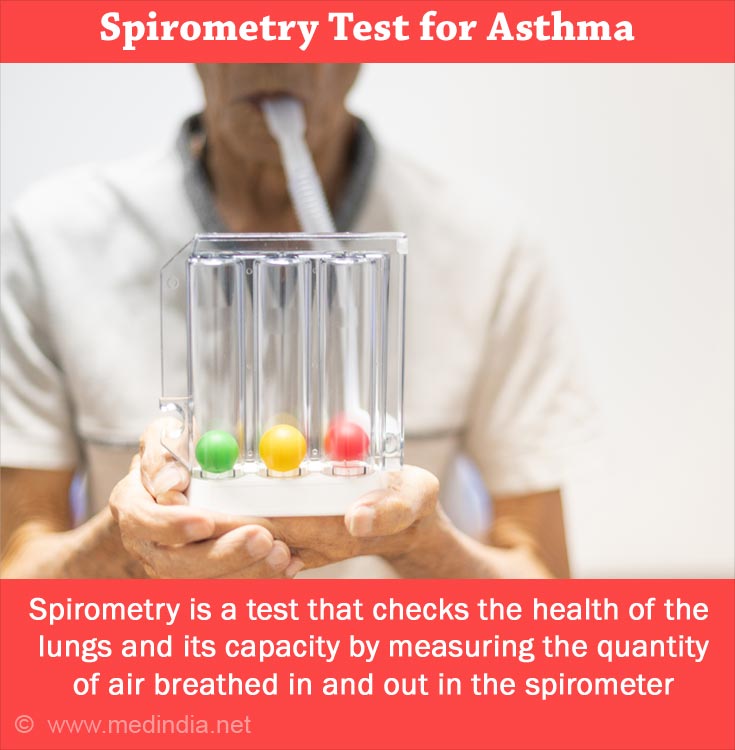- Asthma: Testing & Diagnosis - (http://my.clevelandclinic.org/health/diseases_conditions/hic_asthma_an_overview/hic_diagnosing_asthma)
- Severe Asthma: Definition, Diagnosis and Treatment - (https://www.ncbi.nlm.nih.gov/pmc/articles/PMC4357024/)
- Classification of asthma according to revised 2006 GINA: evolution from severity to control - (https://www.ncbi.nlm.nih.gov/pmc/articles/PMC2732074/)
- Asthma - (http://www.nhlbi.nih.gov/health/health-topics/topics/asthma/diagnosis)
- Asthma diagnosis in otolaryngology practice: pulmonary function testing - (https://pubmed.ncbi.nlm.nih.gov/24286677/)
- Asthma - (https://www.ncbi.nlm.nih.gov/books/NBK430901/)
- Diagnosis of asthma: diagnostic testing - (https://pubmed.ncbi.nlm.nih.gov/26335833/)
- Peak Flow Rate Measurement - (https://www.ncbi.nlm.nih.gov/books/NBK459325/)
- Allergy Testing - (https://pubmed.ncbi.nlm.nih.gov/30725705/)
- FeNO in Asthma - (https://pubmed.ncbi.nlm.nih.gov/35253144/)
- Asthma control test and asthma quality of life questionnaire association in adults - (https://pubmed.ncbi.nlm.nih.gov/23264406/)
- Bronchodilator reversibility as a diagnostic test for adult asthma: findings from the population-based Tasmanian Longitudinal Health Study - (https://pubmed.ncbi.nlm.nih.gov/33585659/)
- Sputum analysis in diagnosis and management of obstructive airway diseases - (https://pubmed.ncbi.nlm.nih.gov/18360557/)
- Asthma outcomes: biomarkers - (https://www.ncbi.nlm.nih.gov/pmc/articles/PMC3390196/)
- Asthma - (https://pubmed.ncbi.nlm.nih.gov/22349173/)
What is Asthma?
In 1918, Francis M. Rackemann classified asthma as ‘allergic asthma’ and ‘intrinsic asthma’. Allergic asthma is due to allergens, while non-allergen-induced asthma is known as intrinsic asthma. Currently, with more research data on asthma, the classification has been modified based on the control of the disease(1✔ ✔Trusted Source
Severe Asthma: Definition, Diagnosis and Treatment
Go to source).
The Global Initiative for Asthma (GINA) has classified asthma into 3 main categories: controlled, partly controlled, and uncontrolled. Controlled asthma shows no or minimal symptoms with near normal lung function. Partly controlled asthma has more than a couple of episodes during the week. In addition, the patient may show limitation of activity, nocturnal symptoms, lung function < 80% predicted or personal best, and one or more exacerbation per year. Uncontrolled asthma displays three or more asthmatic features of partly controlled asthma during a week with one exacerbation in any week.
Other classifications of asthma are based on clinical symptoms and the peak expiratory flow (PEF) values obtained in lung function tests. Asthma is classified as intermittent and persistent. In intermittent asthma (PEF ≥ 80% predicted), individuals experience asthma infrequently. There are large gaps between each episode and when they occur, it is sometimes just one episode in a week. Nocturnal episodes are less than twice a month.
Persistent asthma is sub classified into mild, moderate, and severe. In persistent asthma, the symptoms occur more than once every week. In mild persistent asthma (PEF 80% predicted), there is either one or no episode each day, and the nocturnal symptoms occur more than twice a month. In moderate persistent asthma (PEF 60%-79% predicted), there are daily attacks, and the nocturnal episodes occur more than once each week. In severe persistent asthma (PEF 60% predicted), there are continuous episodes during the day and night, affecting the individual’s productivity(2✔ ✔Trusted Source
Classification of asthma according to revised 2006 GINA: evolution from severity to control
Go to source).
So, what exactly does the term 'asthma' signify? Bronchial asthma, commonly known as asthma, is a chronic condition that is commonly observed, which causes respiratory distress and sudden attacks that can sometimes be fatal. Asthmatic attacks are characterized by wheezing, shortness of breath, coughing, and tightness of the chest. Dust, pollen, house mites, cockroaches, viruses, exercise, smoke, and stress can trigger asthmatic attacks. Approximately 300 million individuals worldwide are affected and can cause a health burden to the healthcare systems. The productivity at work and the quality of life of the family is disrupted.
Tests for Asthma
Asthma in individuals is diagnosed based on the physical manifestations of the condition. The family or medical history is also important in making the accurate diagnosis. Your healthcare provider may use a variety of breathing tests and laboratory tests to diagnose asthma. The pulmonary function test is an important diagnostic modality in the workup of asthmatic patients(3✔ ✔Trusted Source
Asthma diagnosis in otolaryngology practice: pulmonary function testing
Go to source).
Medical and family history
The individual is questioned on the kind of symptoms and the frequency with which it occurs. The frequency may be dependent on the time of the year, or the place, or the diet. Individuals will be questioned on their lifestyle, their routine at home and at work, and the kind of medications they take. Exposure to other factors like pollen, tobacco smoke, dander of pets, dust will be looked into as well.
Medical conditions which can trigger asthma include - sinusitis, psychological stress, sleep apnea, runny nose, and old age among others.
Some conditions that produce symptoms similar to asthma and should be ruled out include:
- Bronchiolitis
- Gastroesophageal reflux disease (GERD)
- Chronic obstructive pulmonary disease (COPD)
- Cystic fibrosis (CF)
- Heart failure
- Pulmonary embolism
- Side effects of drugs

The doctor will enquire about the family history of the patient. If there is a history of asthma in the family, it will be clear that the asthma is genetic in origin.(4✔ ✔Trusted Source
Asthma
Go to source)
Physical signs of asthma:
The doctor will check the nose, eyes, ears, chest, throat, and lungs. The doctor will check for rashes, swollen nasal passages, runny nose, cough, and wheezing, as these are the typical symptoms of allergies or asthma.Diagnostic Evaluation of Asthma
Spirometry test:
This test checks the health of the lungs by measuring the quantity of air breathed in and out. The amount of air exhaled can be measured with a spirometer that is connected to a funnel-like device that captures the exhaled air. The FEV refers to the forced expiratory volume in 1 second as measured by spirometry. The test should be performed before the start of medications, 3 to 6 months following medications, and at regular intervals during the course of the condition(5✔ ✔Trusted SourceDiagnosis of asthma: diagnostic testing
Go to source).

Peak flow test:
Peak flow test is a simple blow test used to diagnose and monitor asthma. The speed with which the air is breathed out is a measure of the efficiency of the airways. This measurement is also known as the peak expiratory flow (PEF) measurement. If the airways are narrow or there is a change in their diameter, it affects the amount of air exhaled into the peak flow meter. A peak flow meter is a reliable device that can be handheld and measures the amount of air exhaled into the device. After an initial reading, individuals are administered medication (bronchodilator) and then observed to see if the results are improved. If there is an improvement, the result combined with the medical history can confirm the diagnosis of asthma.The peak flow meter alone cannot confirm the diagnosis of asthma. Doctors recommend using the peak flow meter at home to determine asthmatic symptoms. Children older than 7 years can use the peak flow meter. During treatment and control of asthmatic symptoms, the peak flow meter should be used to record the score daily for approximately 2 weeks. This gives the best symptom-free score. Based on this score, one can assess the risk of future asthma attacks when the score drops. This can be recorded in the Asthma Action Plan of the patient and can be discussed with the physician to make appropriate changes in the asthma medications
To record on a peak flow meter, one must stand up, set the meter to 0, take in a deep breath, and then close the mouth over the meter to blow out fast and hard into the meter for 2 seconds. This procedure should be repeated 3 times to obtain the highest score.
The readings that are taken before and after an episode, during normal periods, and during a visit to the physician will be variable and when the variability of PEF ≥ 20%, it confirms the presence of asthma(6✔ ✔Trusted Source
Peak Flow Rate Measurement
Go to source).
Allergy test:
This test uses different types of allergens to understand which specific allergen may trigger asthma. Allergy tests include blood tests, and skin prick tests among others. These tests are expensive and are performed in specialized cases when the diagnosis of asthma cannot be confirmed with other tests. These tests are also utilized in research centers(7✔ ✔Trusted Source
Allergy Testing
Go to source).

Nitric oxide test (FeNO test):
This is a test that could be possibly used in the diagnosis of asthma in the future. In this test, the level of exhaled nitric oxide (FeNO) is determined in the breath of asthmatic patients. The level of nitric oxide is higher in inflamed airways. It is a non-invasive test that identifies the type of asthma, improves the diagnosis of the condition, and also indicates the response of the individual to corticosteroid treatment. FeNO testing is a low-cost, non-invasive procedure that can be used as a surrogate biomarker in the diagnosis and management of severe asthma.Bronchoprovocation is a test where the individual is exposed to possible triggers, to see if he / she develops asthma symptoms. This test is no longer routinely performed to diagnose asthma(8✔ ✔Trusted Source
FeNO in Asthma
Go to source).
Asthma Control Test (ACT):
This test is a 5-item questionnaire that measures asthma control in the patient. This test is repeated every 4 weeks(9✔ ✔Trusted SourceAsthma control test and asthma quality of life questionnaire association in adults
Go to source).
Reversibility test:
This is normally carried out to ensure that the individual suffers from asthma and not other conditions that mimic the symptoms of asthma. In such cases, individuals are treated with either prednisolone or a bronchodilator. If either of these medications provides relief, then non-asthmatic conditions may be ruled out(10✔ ✔Trusted SourceBronchodilator reversibility as a diagnostic test for adult asthma: findings from the population-based Tasmanian Longitudinal Health Study
Go to source).
Other tests that can be performed to detect the signs of asthma or rule out other causes of wheezing and other symptoms are as follows:
Electrocardiogram (EKG):
An electrocardiogram is used to test for heart failure or other problems that could arise in patients with prolonged asthma. In addition, it can help differentiate wheezing due to respiratory and cardiac problems.X-ray chest:
A chest x-ray is used to rule out any other cause of wheezing and other respiratory symptoms(4✔ ✔Trusted SourceAsthma
Go to source).
Gastroesophageal reflux tests:
pH measurements for 24 hours can detect gastroesophageal reflux or heartburn, which can also cause tightness of the chest similar to asthma.Sputum induction tests:
In these tests, the mucus discharge from the nose and the saliva are tested for eosinophils. These white blood cells are present in response to an inflammation. These cells can be stained red with the staining dye, eosin(11✔ ✔Trusted SourceSputum analysis in diagnosis and management of obstructive airway diseases
Go to source).
Sinus X-rays:
X-rays of the sinuses can help to rule out sinusitis, which can precipitate asthma attacks in some patients.All guidelines recommend the use of biomarkers, such as FeNO, IgE or blood eosinophil counts to characterize severe asthma, Complete blood counts (CBC blood test) to measure total eosinophils, fractional exhaled nitric oxide (FeNo), sputum eosinophils, urinary leukotrienes, and total and allergen-specific IgE are recommended to diagnose asthma(12✔ ✔Trusted Source
Asthma outcomes: biomarkers
Go to source).
Treatment for Asthma
The basic treatment for asthma includes the use of inhalers that contain corticosteroids and bronchodilators. If inhalers are not effective, oral corticosteroids, such as prednisolone are prescribed. For the treatment to be successful, individuals need to use inhalers appropriately to receive the full effect of the drug. Sensitive individuals should be aware of the triggers of asthma and avoid situations that can be detrimental to their health.
Asthma is a condition that can be managed. There is no cure for the disease. Effective diagnosis and treatment can improve the health and the productivity of individuals(13✔ ✔Trusted Source
Asthma
Go to source).







